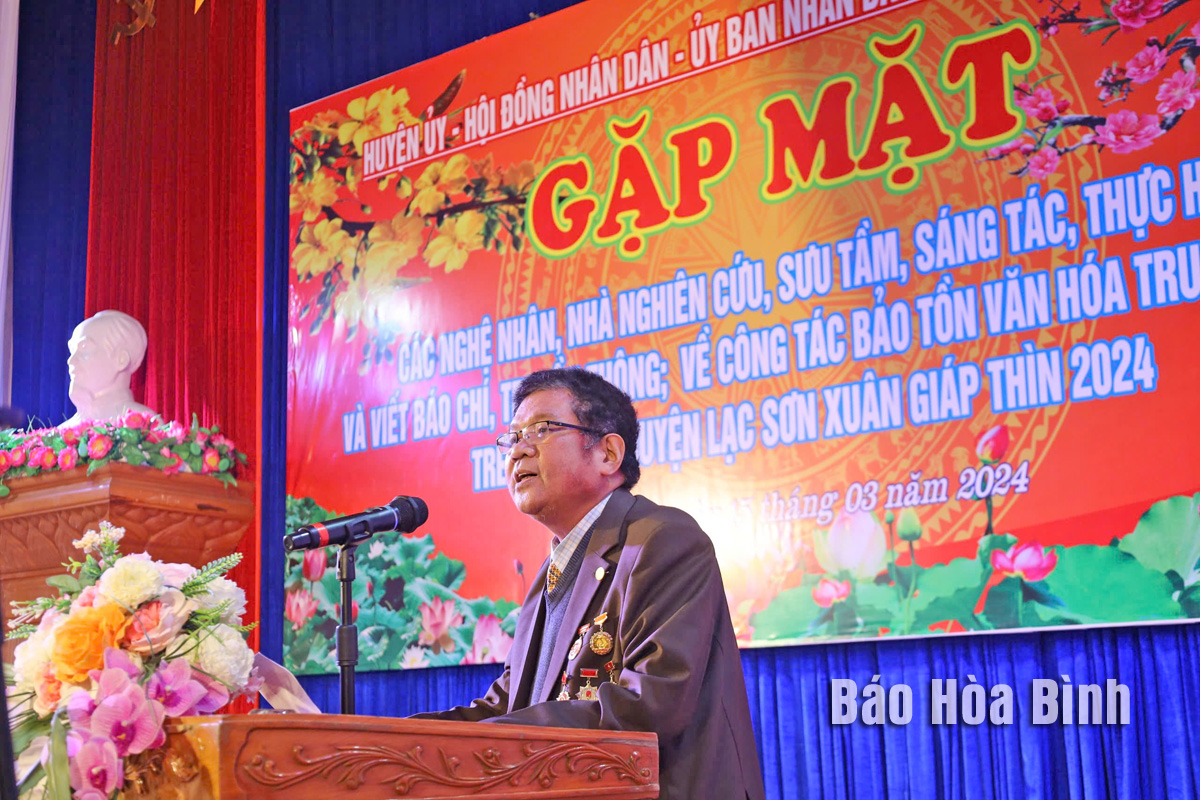
Having applied himself to researching and preserving traditional culture, Meritorious Artisan Bui Huy Vong in Huong Nhuong commune, Lac Son district, has won high regard from many people for his dedication to the Muong ethnic culture.
Meritorious Artisan Bui Huy Vong shares his journey to
research and preserve the Muong ethnic group’s culture.
Vong said researching and preserving the Muong
culture and bringing into play the good cultural values of ancestors in the
modern life is an arduous journey. However, thanks to support from district and
grassroots authorities as well as local artisans, he has obtained certain
achievements.
In particular, he has helped with the
restoration of some traditional festivals such as those of the Khenh Communal
House in Van Son commune, the Bang Communal House in Ngoc Son commune, and the
Khoi Communal House in An Nghia commune. He has written and published nearly 20
books, about 10 scientific articles on specialised magazines, along with
hundreds of articles, short stories, and research papers on central and local
media agencies.
Recalling difficulties and endeavours in the
restoration of local temples and festivals, Vong noted it took almost 10 years,
from 2001 to 2010, to rehabilitate the main hall of the Bang Communal House,
but it was not until 2016 that the Chay Dat - Chay Muong ritual of this site’s
festival was revived. Besides, it took up to 15 years, from 2003 to 2018, to
have the main hall and festival of the Khenh Communal House restored.
As the core zone of the Muong culture, Lac Son
district has also paid attention to revitalising the Muong ethnic singing. As a
result, the folk singing movement has become popular in the local community
over the last 10 years. Five clubs of "thuong rang” and "bo meng”, two types of
the Muong folk singing, have come into being, drawing more than 200 artisans.
Not only an artisan, collector, and researcher,
Vong is also one of the first person to post video clips about the Muong
singing on YouTube, attracting millions of viewers.
However, he is still concerned that many
valuable cultural heritages like the Vanh village stone shelter, the Trai
hamlet cave, Mo Muong, Muong gongs, as well as the customs and folk songs of
Muong people remain untapped. District authorities have just restored traditional
festivals and utilised the ethnic group’s space and cuisine for tourism
development.
Vong expressed his hope that the local Party
Committee and People's administration will hold regular meetings with artisans,
collectors, researchers, and those preserving the traditional culture. They
should create a space at major events and folk festivals for Muong singing
artisans in Lac Son, as well as those from across Hoa Binh province and other
localities, to engage in exchanges. In addition, it is important to pay more
heed to tourism promotion to bring into play the role of the local community
and artisans of the Muong culture.
With an increasingly vibrant and widespread emulation movement aimed at building cultured residential areas and cultured families, Yen Thuy District has been making steady progress toward improving both the material and spiritual well-being of its people, while fostering a civilized, prosperous, beautiful, and progressive community.
Once lacking recreational spaces and community facilities, Residential Group 2 in Quynh Lam Ward (Hoa Binh City) has recently received attention for the construction of a new, spacious, and fully equipped cultural house. The project followed the model of state support combined with public contributions in both labor and funding.
The "All people unite to build cultural life" movement, which has been effectively integrated with Kim Boi district’s socio-economic development goals, is fostering a lively spirit of emulation across local residential areas, hamlets, villages, public agencies, and enterprises. In addition, through the initiative, traditional cultural values are being preserved and promoted, while community solidarity and mutual support in poverty reduction and economic development are being strengthened.
A working delegation of the Hoa Binh provincial People’s Committee led by its Permanent Vice Chairman Nguyen Van Toan on June 11 inspected the progress of a project to build the Mo Muong Cultural Heritage Conservation Space linked to tourism services in Hop Phong commune, Cao Phong district.
Born and growing in the heroic land of Muong Dong, Dinh Thi Kieu Dung, a resident in Bo town of Kim Boi district, in her childhood was nurtured by the sweet lullabies of her grandmother and mother. These melodies deeply imprinted on her soul, becoming an inseparable part of her love for her ethnic group's culture. For over 20 years, this love for her hometown has driven Dung to research, collect, and pass down the cultural values of the Muong people to future generations.
In the final days of May, the Ethnic Art Troupe of Hoa Binh Province organized performances to serve the people in remote, mountainous, and particularly disadvantaged areas within the province. These were not just ordinary artistic shows, but they were the meaningful journeys aimed at spreading cultural values, enhancing the spiritual life of the people and contributing to the preservation of ethnic minority cultural identities.



